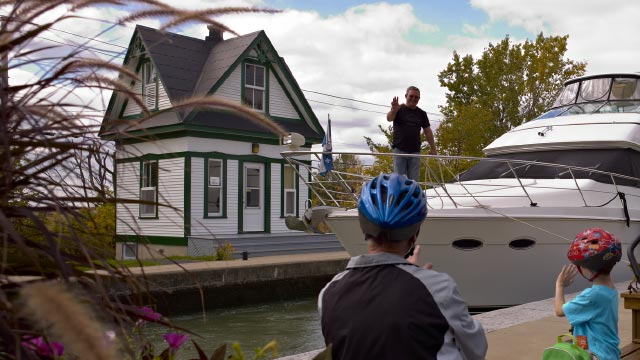
A waterway on the move
Chambly Canal National Historic Site
Although its vocation has changed from commercial shipping to pleasure boating, the Chambly Canal has retained its original function as an operational waterway since it opened in 1843. Over the years, the canal and its structures have undergone substantial maintenance work to improve navigation, but especially to encourage trade between Canada and the United States via the Richelieu River and Lake Champlain. As the manager of this National Historic Site, Parks Canada continues to carry out work to preserve the canal’s infrastructure, operate it as a historic canal, and document its history and share it with the public.
A navigable waterway and structures that have changed over time

While the Chambly Canal was in commercial operation between 1843 and May 1972, a number of projects and measures were carried out to make it a better water transportation route between Canada and the United States via the Richelieu River. The canal authorities undertook considerable work between the 1880s and the beginning of the 20th century. Its appearance changed with the introduction of new building materials during that period. The locks were built in the timber and masonry style, which means that part of their walls was built of wood and the rest of masonry. This type of construction, which is very sustainable, makes the structure of the Chambly Canal unique among Canadian canals.
At the same time, the depth and width of some sections of the canal were changed. The configuration was altered in specific places. The gabion walls were also built during this period. Recently replaced with identical replicas, these walls can still be seen in the sector between the canal workshops and Lock No. 4 in Chambly. Although the canal and its many structures have changed over time, its original footprint and most of its towpath remain. The locks and their size are a reminder of the ships that once used them, making the Chambly Canal an authentic barge canal.
Operating and conserving the cultural resources of the Chambly Canal
Designated a National Historic Site by the federal government in 1929, the Chambly Canal was transferred to the administration of Parks Canada in June 1972. Since then, the government agency has carried out significant work to make the canal operational, but also to respect its historical character.

In Chambly, for example, the combined locks Nos. 1, 2 and 3 still have a number of elements dating back to the initial construction of the canal, such as the floor (1840 to 1842) made of stone masonry. Since the early 1990s, the manual operation of both the hydraulic system of the doors of Lock No. 3 and the operation of the sluices of Locks Nos. 1, 2 and 3 have been restored. The presence of the Superintendent’s residence and lockhouses, built at the beginning of the 20th century in the Queen Anne Revival style, reinforces the historical character of the Chambly Canal’s combined locks sector.
We find contemporary buildings inspired by this architectural style in other sectors of the canal. In Saint-Jean-sur-Richelieu, the current lockhouse at Lock No. 9, built in the mid-1990s in the spirit of the Queen Anne Revival style, is a reminder of the embellishment and landscaping actions taken at the turn of the 20th century along the canal and contributes to the fine balance between contemporary developments and the preservation of Lock No. 9 surroundings.
The preservation of a 20-kilometre-long national historic site such as the Chambly Canal, located in an urban, near-urban and rural setting, has presented some stimulating challenges. Major infrastructure work carried out recently will allow the canal in operation while protecting and enhancing this historic waterway, a valuable heritage asset for current and future generations.
Matthieu Paradis
Cultural Resources Advisor
Parks Canada
- Date modified :